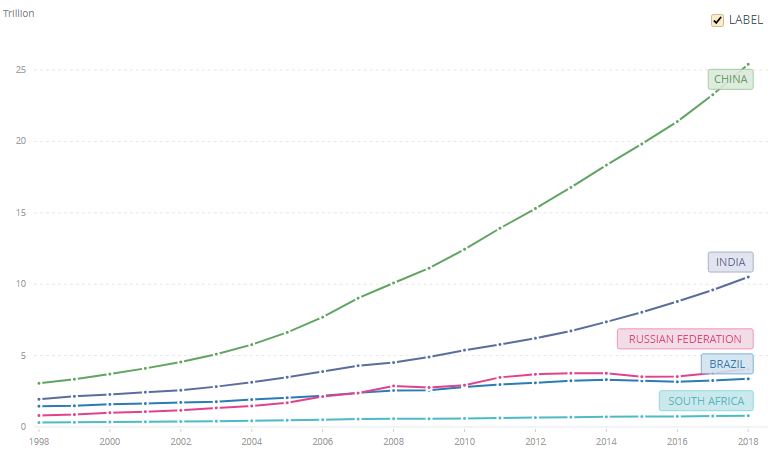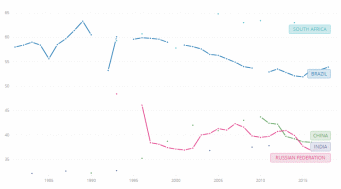Introduction
COVID-19 pandemic is one of the most impactful events of the first quarter of the twenty-first century that has an influence on almost every aspect of human lives. The global economy suffered severely from the coronavirus outbreak, as the global trade was affected considerably. According to Jones, Palumbo, and Brown (2020), Dow Jones fell by 18.5%, while the FTSE100 index lost 24.5% between January and May 2020. Many people became unemployed and faced emerging poverty. In the US, more than 30 million people filed for unemployment benefits between the middle of March and the end of April (Jones, Palumbo, and Brown, 2020). These changes are likely to affect wealth distribution in all countries. The present paper offers the analysis of the Gini Index will evolve in BRICS countries during the next three years.
Background Information
BRICS Countries
BRICS is an acronym for the association between five countries, which are Brazil, Russia, India, China, and South Africa. Even though these five countries are referred to as developing, they are expected to become leading suppliers of manufactured goods, services, and raw materials in the world (Majaski, 2020). Even though these countries are often referred to as a group, they have not established coherent trade unions (Majaski, 2020). The critique of the organization is that it ignores the finite nature of natural resources, such as fossil fuels, uranium, and metals (Majaski, 2020). However, the economies of the countries continue to grow, and, in 2014, 30% of the global gross domestic product (GDP) was accounted for BRICS countries (Majaski, 2020). GDP based on purchasing power parity change is demonstrated in Figure 1. The distribution of wealth in these countries has changed considerably since the beginning of the twenty-first century. The present paper will analyze only Brazil and Russia as examples of BRICS countries.

Gini Index
The Gini index is a statistic of wealth distribution that is often utilized to measure economic inequality. The ratio varies from zero to one, where zero is perfect equality (everyone has the same income level), and one is perfect inequality (all the money belongs to one person) (Chapellow, 2020). In other words, the lower the Gini coefficient, the more equal the distribution of wealth. The coefficient is often presented graphically using the Lorenz Curve, which shows the income distribution “by plotting the population percentile by income on the horizontal axis and cumulative income on the vertical axis” (Chapellow, 2020, para. 9). The Gini coefficient is the area between the line of equality and the Lorenz curve multiplied by 2 (Chapellow, 2020). Currently, the Gini Index in different countries varies between 30% and 60%, with the highest index in South Africa and Brazil (Chapellow, 2020). While the metric is useful for analyzing a country’s economic well-being, it relies heavily on accurate measures of GDP and per capita income levels. This method does not take into consideration shadow markets, which are common in developing countries, including BRICS.
Gini Index in Russia
During the past three decades, Russia has been an inconsistent performer in terms of the Gini Index. The coefficient was as high as 48.4% in 1993 and as low as 36.8% in 2016 (World Bank, 2020). The Russian Federation had the lowest Gini Index value among all the BRICS countries since 2015 (see Figure 2). Such a tendency usually signals that the country’s government could employ efficient strategies to improve wealth distribution in the country. However, this may not be the case with Russia, as the index may demonstrate the changes in the shadow economy of the country. According to Cordell (2019), the size of the shadow economy in the Russian Federation has decreased drastically during the last decade, which implies that the Gini Index is becoming more accurate, as it measures the official economy.

COVID-19 pandemic is associated with one of the most impactful financial crises in history. The influence of economic crises on wealth inequality is a well-studied phenomenon discussed by many scholars and professionals. According to Beaten (2016), pre-crisis periods are usually associated with a rise in income inequality, whthe post-crisis periods usually decrease income inequality. This effect is related to the fact that the richest 10% are stricken by the crises the most and lose much of their wealth (Beaten, 2016). At the same time, governments around the world usually try to decrease the gap between the rich and poor to stabilize the economy (Beaten, 2016). Moreover, the pandemic hit the shadow economy the most, as the informal market lost almost 60% of its value (International Labor Organization, 2020). Such a tendency is expected to encourage people to come out of the shadow market to be more protected.
Considering the changes mentioned above, the Gini Index in Russia is expected to drop considerably. During the previous financial crisis of 2008, the coefficient fell from 42.3% in 2007 to 39.5% in 2010, which is almost a 3-point improvement (World Bank, 2020). Considering the fact the financial crisis brought by the pandemic is comparable in size to the crisis of 2008, the Gini Index is expected to drop from the current 37.5% to 34%-35% during three years after the outbreak (World Bank, 2020). However, the index may fall even lower due to the Russia-Saudi Arabia oil price war, which may decrease the wealth of the richest in Russia even further.
Gini Index in Brazil
Brazil has had the Seco had nd-highest Gini index among the BRICS countries since 1996. In 2018, the coefficient was 53.9%, which is almost 10% lower than in 1989. As seen in Figure 2, Brazil’s Gini index has been going down slowly at the beginning of the 1990s. However, while the dynamic is favorable, Brazil is still an extremely unequal country in terms of wealth distribution. According to Oxfam International (no date), the six richest men in Brazil are as wealthy as the poorest 50% of the population combined. The country’s richest 5% earn as much as the other 95% (Oxfam International, no date). The data demonstrates that the country needs to address some of the structural causes of inequality.
As mentioned by Beaten (2016), economic crises can be a reason for the government’s interventions to redistribute wealth inside the country. However, this was not the case in Brazil in 2008, when the Gini Index remained virtually unchanged (World Bank, 2020). This implies that the government’s policy is designed to support the elite. Therefore, the COVID-19 pandemic is not expected to have any significant effect on the Gini Index in Brazil. Slight changes towards better wealth distribution can emerge; however, the coefficient is not likely to drop 52 during the next two years.
Conclusion
Gini Index is a statistic utilized to measure wealth distribution. While the method is widely used, it has several drawbacks that need to be regarded when discussing income equality. COVID-19 pandemic is expected to have an indirect effect on Gini coefficient in all countries, including BRICS members. The presented analysis, however, demonstrates that the effect of the pandemic will vary among countries. In general, as COVID-19 will cause a financial crisis, the Gini Index is expected to go down in most countries.
References
- Baeten, L. (2016) The effects of financial crises on income inequality: Evidence in the long run of history. Web.
- Chapellow, J. (2020) What is the Gini Index? Web.
- Cordell, J. (2019) ‘How big is Russia’s shadow economy and why does it matter?’ The Moscow Times. Web.
- International Labor Organization (2020) ILO: As job losses escalate, nearly hal he of the global workforce at risk of losing livelihoods. Web.
- Jones, L., Palumbo, D., and Brown, D. (2020) ‘Coronavirus: A visual guide to the economic impact’, BBC News. Web.
- Majaski, C. (2020) Brazil, Russia, India, and China (BRIC). Web.
- Oxfam International (no date) Brazil: Extreme inequality in numbers. Web.
- World Bank (2020) GINI index (World Bank estimate) – Brazil, China, India, Russian Federation, South Africa. Web.